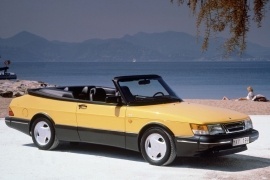
SAAB 900 Cabrio
Generations Timeline, Specs and Pictures

In 1994, the Swedish company Saab introduced the second generation of the 900 model which is entirely based on the Opel Vectra chassis.
Dubbed the “new generation”, the new Saab 900 series had four engine versions, as it follows: 2.0 Turbo, 2.0i, 2.3i and 2.5 V6. The most powerful engine, the 2.0-liter Turbo, develops 185 horsepower and is able to push the car to a top speed of 143 mph, with a 0 to 62 mph acceleration in 8.5 seconds. It’s important to note that the convertible version of the Saab 900 was manufactured on the previous chassis for one more year, being them upgraded to the new one also used by the second generation.

Saab introduced a new generation for the 900 lineup in 1978, but since the snow is more present in Sweden than the sun, the carmaker didn’t bother to make an open-top version for it.
But the carmaker tried to export the car to other countries, and it was quite successful. When it sent the car to the U.S. market, the customers were stunned by the turbocharged engines. But all premium carmakers offered a rag-top version for their coupes, while Saab didn’t. The U.S. importer suggested to the carmaker that it should offer one to increase the sales. There were a few offers from custom coachbuilders, but the Swedish carmaker was not pleased by their results. It ended up by asking its design department to create one, and the result was far better. Last but not least, Saab produced the car at Valmet Automotive just across the border in Finland.
Saab unveiled the 900 Cabrio in 1986, and it looked special. The front of the car kept the same front fascia with rectangular headlights. It’s steep but curved on the sides, and the windshield was inspired by former Saab fighter jets. A black rubber spoiler adorned its sloped trunk and the power-operated roof featured two layers for better sound and temperature insulation.
Inside, Saab kept the same interior from the two-door coupe, from which the Cabrio was derived. Its dashboard designed around the driver enhanced the driving experience. Since the car was based on the two-door coupe version, not on the three-door hatchback, the car could retract the rag-top behind the rear seats completely. Thus, it provided adequate legroom for the rear passengers. It was not a car just for two.
Under the hood, Saab used its special, turbocharged gasoline engines that offered up to 175 hp. It paired them with either a five-speed manual or a three-speed automatic.























































